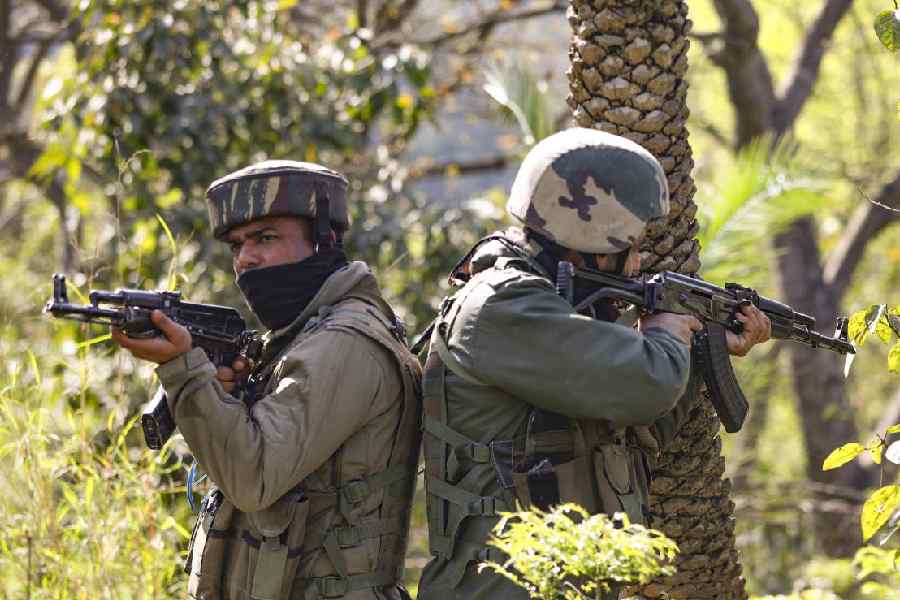 |
 |
| (From top) A CPM cadre camp in Nayagram destroyed by the Maoists. Sandbags lie strewn on the ground; a cabin at the base of a cellphone tower that was used by CPM cadres to ward off Maoists in the West Midnapore pocket. (Pranab Mondal) |
Nayagram (West Midnapore), Dec. 24: Littered sandbags, deserted bunkers and broken-down camps. Nayagram presents a picture of contrast to the other Maoist redoubts in the district that have been “recaptured” by the CPM.
Nayagram, like Salboni, Lalgarh and Dharampur, too, had been overrun by the Marxists about six months ago and the one-time Maoist stronghold had been turned into a CPM fortress.
However, unlike the other places, Nayagram is the only place in the district where the rebels have been able to destroy the CPM’s fortified camps and re-establish their hold.
This is because the Maoists enjoy a geographical advantage here: Nayagram adjoins Orissa’s forests that facilitate a supply chain through which flow men and arms to the Maoists, unhindered by the joint forces.
“We will turn this area into a second Lalgarh,” a Maoist leader, with an AK-47 slung across his shoulder, told The Telegraph. “We have already destroyed five armed CPM camps here. They will find it very difficult to dislodge us from here. For, we are getting a constant supply of arms and ammunition from Orissa.”
CPM sources said that in May this year, armed party cadres drawn from across the district, with the backing of the joint forces, had entered Nayagram, then a rebel stronghold, and taken over the area. The Maoists had fought back, but the Marxist-joint forces combine was too formidable for them and they had retreated into the Orissa jungles.
But the Marxist victory was shortlived. After the CPM had set up five camps and the joint forces had retreated to their barracks, the Maoists bounced back. Aided with reinforcements from Orissa, the rebels ensured that the CPM was back on the run.
On November 17, in an offensive launched by the Maoists, five CPM leaders were killed in one day and the rest fled the area. The Maoists then overran Nayagram, destroying the CPM camps at will.
The Maoists also raided the house of Kanailal Dutta, the CPM local committee secretary, at Nayagram’s Patina village and took away the arms and ammunition stashed there. Thereafter, 20 armed CPM cadres were forced to surrender. Their lives, however, were spared after they promised to snap all links with the CPM.
“The Maoists wanted to portray that this was a spontaneous peoples’ uprising against the CPM,” said a police officer. “This is why the lives of the surrendered cadres were spared. Killing them would have made it appear a cold-blooded Maoist operation.”
The Maoists have also blown up a bridge on the road from Gopiballavpur, which has a joint forces camp, to Nayagram to prevent the police from advancing into the area.
The CPM blames not just the Maoists but also the Trinamul Congress for the attack on the party’s camps. “It was a joint operation by them,” said Swadesh Kuila, the local committee member of Patina. “We have been forced to flee our villages after many of our leaders were killed. We are homeless again and unable to return because of the terror unleashed by the Maoists and Trinamul.”
Ujjwal Das, Trinamul’s Nayagram block president, contested the charge, saying it was “a matter between the CPM and the Maoists”. “But the CPM activists left their party because they were fed up with the leadership,” Das said.
A police officer said Maoist leaders like Bikash, Sanjay Pratihar and Akash, who were once active in Lalgarh, were now overseeing the Maoist operations in Nayagram.
Bidhan Bhattacharjee, the inspector in charge of Nayagram, tamely admitted: “The Maoists always get to know when we are coming and just flee into Orissa. They re-emerge once we are gone.”











